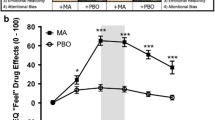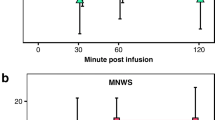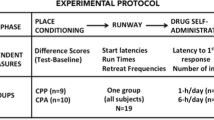Abstract
Rationale
Studies with laboratory animals demonstrating different effects of self- vs experimenter-administered drug suggest that the ability to control or predict drug delivery may be an important determinant of drug action.
Objective
This study assessed whether self-administered and yoked cocaine injections produce different effects in humans.
Methods
Ten inpatient volunteers with experience in using cocaine participated in a double-blind, yoked design during which four experimental test sessions were conducted. During two sessions, participants controlled if and when up to six 40 mg/70 kg i.v. cocaine injections were given. During two sessions, participants received noncontingent exposure to the same pattern of injections given during the preceding session (i.e., yoked) under blind conditions. Sessions followed a fixed-order, ABAB design. Measures of subjective and physiological response to cocaine were taken throughout each session.
Results
Cardiovascular safety parameters were exceeded in some individuals after yoked, but not self-administered, cocaine resulting in some scheduled injections being delayed or withheld. Mean systolic and diastolic blood pressures were higher following yoked compared to self-administered cocaine. In contrast, analysis of the subjective effects revealed only small and generally nonsignificant differences in the effects of self-administered vs yoked cocaine.
Conclusions
These results suggest that under the laboratory methods employed, control over the schedule of drug delivery may not alter the subjective effects of cocaine in humans. In contrast, the cardiovascular effects of cocaine appear to be greater when the drug is administered noncontingently.



Similar content being viewed by others
References
Borysenko M, Borysenko J (1982) Stress, behavior, and immunity: animal models and mediating mechanisms. Gen Hosp Psychiatry 4:59–67
Church RM (1964) Systematic effect of random error in the yoked control design. Psychol Bull 62:122–131
Di Ciano P, Blaha CD, Phillips AG (1996) Changes in dopamine oxidation currents in the nucleus accumbens during unlimited-access self-administration of d-amphetamine by rats. Behav Pharmacol 7:714–729
Donny EC, Caggiula AR, Rose C, Jacobs KS, Mielke MM, Sved AF (2000) Differential effects of response-contingent and response-independent nicotine in rats. Eur J Pharmacol 402:231–240
Donny, EC, Bigelow, GE, Walsh, SL (2004) Assessing the initiation of cocaine self-administration in humans during abstinence: effects of dose, alternative reinforcement, and priming. Psychopharmacology (Berl) 172:316–323
Dudish-Poulsen SA, Hatsukami DK (1997) Dissociation between subjective and behavioral responses after cocaine stimuli presentations. Drug Alcohol Depend 47:1–9
Dworkin SI, Porrino LJ, Smith JE (1992) Importance of behavioral controls in the analysis of ongoing events. NIDA Res Monogr 124:173–188
Dworkin SI, Mirkis S, Smith JE (1995) Response-dependent versus response-independent presentation of cocaine: differences in the lethal effects of the drug. Psychopharmacology (Berl) 117:262–266
First M, Spitzer R, Gibbon M, Williams J (1995) Structured clinical interview for DSM-IV axis 1 disorders. Biometrics Research Department, New York State Psychiatric Institute, New York
Fischman MW (1989) Relationship between self-reported drug effects and their reinforcing effects: studies with stimulant drugs. NIDA Res Monogr 92:211–230
Foltin RW, Fischman MW, Levin FR (1995) Cardiovascular effects of cocaine in humans: laboratory studies. Drug Alcohol Depend 37:193–210
Gillis RA, Hernandez YM, Erzouki HK, Raczkowski VF, Mandal AK, Kuhn FE, Dretchen KL (1995) Sympathetic nervous system mediated cardiovascular effects of cocaine are primarily due to a peripheral site of action of the drug. Drug Alcohol Depend 37:217–230
Hemby SE, Co C, Koves TR, Smith JE, Dworkin SI (1997) Differences in extracellular dopamine concentrations in the nucleus accumbens during response-dependent and response-independent cocaine administration in the rat. Psychopharmacology (Berl) 133:7–16
Kiyatkin EA, Wise RA, Gratton A (1993) Drug- and behavior-associated changes in dopamine-related electrochemical signals during intravenous heroin self-administration in rats. Synapse 14:60–72
Knuepfer MM (2003) Cardiovascular disorders associated with cocaine use: myths and truths. Pharmacol Ther 97:181–222
Martin WR, Sloan JW, Sapira JD, Jasinski DR (1971) Physiologic, subjective, and behavioral effects of amphetamine, methamphetamine, ephedrine, phenmetrazine, and methylphenidate in man. Clin Pharmacol Ther 12:245–258
Mineka S, Hendersen RW (1985) Controllability and predictability in acquired motivation. Annu Rev Psychol 36:495–529
Moolten M, Kornetsky C (1990) Oral self-administration of ethanol and not experimenter-administered ethanol facilitates rewarding electrical brain stimulation. Alcohol 7:221–225
Mutschler NH, Miczek KA (1998) Withdrawal from a self-administered or non-contingent cocaine binge: differences in ultrasonic distress vocalizations in rats. Psychopharmacology (Berl) 136:402–408
Resnick RB, Kestenbaum RS, Schwartz LK (1977) Acute systemic effects of cocaine in man: a controlled study by intranasal and intravenous routes. Science 195:696–698
Smith JE, Co C, Freeman ME, Sands MP, Lane JD (1980) Neurotransmitter turnover in rat striatum is correlated with morphine self-administration. Nature 287:152–154
Smith JE, Co C, Freeman ME, Lane JD (1982) Brain neurotransmitter turnover correlated with morphine-seeking behavior of rats. Pharmacol Biochem Behav 16:509–519
Smith JE, Co C, Lane JD (1984) Limbic acetylcholine turnover rates correlated with rat morphine-seeking behaviors. Pharmacol Biochem Behav 20:429–442
Smith JE, Koves TR, Co C (2003) Brain neurotransmitter turnover rates during rat intravenous cocaine self-administration. Neuroscience 117:461–475
Stuber GD, Roitman MF, Phillips PE, Carelli RM, Mark Wightman R (2004) Rapid dopamine signaling in the nucleus accumbens during contingent and noncontingent cocaine administration. Neuropsychopharmacology
Tella SR, Schindler CW, Goldberg SR (1991) Cardiovascular effects of cocaine in squirrel monkeys. NIDA Res Monogr 108:74–91
Tella SR, Schindler CW, Goldberg SR (1999) Cardiovascular responses to cocaine self-administration: acute and chronic tolerance. Eur J Pharmacol 383:57–68
Acknowledgements
This research was supported by grants from the National Institute on Drug Abuse R01 DA10753, R01 DA05196, T32 DA07209, and K05 DA00050. The authors thank the staff at BPRU, especially Jessica Meyer, Melissa Blank, Chad Sawyer, Heather Cronin, Roxanna Kelly, Kellie Lawson, Tim Mudric, Paul Nuzzo, and John Yingling.
Author information
Authors and Affiliations
Corresponding author
Rights and permissions
About this article
Cite this article
Donny, E.C., Bigelow, G.E. & Walsh, S.L. Comparing the physiological and subjective effects of self-administered vs yoked cocaine in humans. Psychopharmacology 186, 544–552 (2006). https://doi.org/10.1007/s00213-006-0312-8
Received:
Accepted:
Published:
Issue Date:
DOI: https://doi.org/10.1007/s00213-006-0312-8




